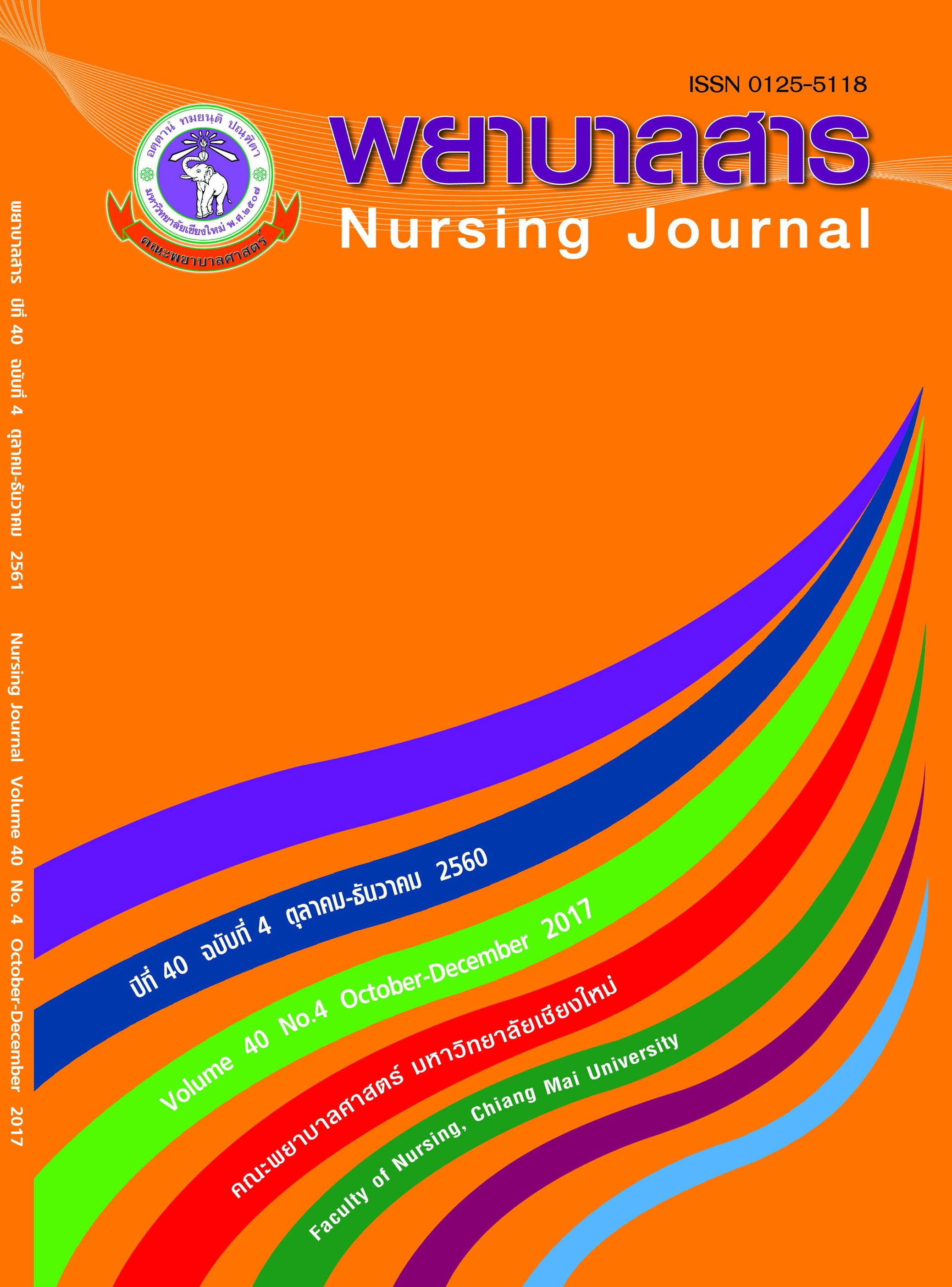Effects of Wound Irrigation Using Pressure Controlled Technique on Satisfaction and Infection Among Persons with Lacerated Wound
Keywords:
Lacerated wound, wound irrigation, wound cleansing, satisfaction, infection woundAbstract
Wound cleansing is an essential procedure to reduce risk of infection in lacerated wounds. This quasi-experimental research aimed to examine the effects of wound irrigation using the pressure controlled technique on satisfaction towards wound cleansing of persons with lacerated wounds and lacerated wound infection. The samples were 44 persons with lacerated wounds attending an emergency room. There were 22 persons in the control group which received routine wound cleansing. The 22 persons in the experimental group received wound irrigation using the pressure controlled technique. Subjects in both groups were matched according to wound size, wound location, time interval from injury to wound management, history of diabetes, and smoking. Wound irrigation using pressure controlled technique instrument was developed by the researcher and validated for wound irrigation pressure by an engineering expert. The instruments used for data collection included the Satisfaction Towards Wound Cleansing Evaluation Form and the Lacerated Wound Infection Evaluation Form, which were developed based upon the Center for Disease Control and Prevention wound infection criteria (Center for Disease Control and Prevention, 2013). Data were analyzed using descriptive statistics, the Mann-Whitney U test and the Fisher Exact Probability test.
The study results revealed the following:
- 1. Satisfaction towards wound cleansing among persons with lacerated wounds in the experimental group (mean = 8.73, SD = 0.70, median 9.00) was statistically significantly higher than the control group (mean = 7.14, SD = 0.71, median 7.00) (p < 0.001).
- 2. The lacerated wound infection among the Subjects in both groups (control group 13.64%, experimental group 0%) was not statistically different (p = 0.12).
The results of this study indicate that wound irrigation using the pressure controlled technique could be used for wound cleaning in a person with a lacerated wound.
References
89(7), 727.
Amenu, D., Belachew, T., & Araya, F. (2011). Surgical site infection rate and risk factors among obstetric cases of Jimma university specialized hospital, southwest Ethiopia. Ethiopian journal of health sciences, 21(2), 91-100.
Blunt, J. (2001). Wound cleansing: Ritualistic or research-based practice?.Nursing Standard,
16(1), 33-36.
Centers for Disease Control and Prevention (CDC). (2013). National Healthcare Safety Network (NHSN). April 2013 CDC/NHSN protocol corrections, clarification, and additions.
Chatterjee, J. S. (2005). A critical review of irrigation techniques in acute wounds. International
Wound Journal, 2(3), 258-265
Cunliffe, P. J., & Fawcett, T. N. (2002). Wound cleansing: The evidence for the techniques and solutions used. Professional Nurse (London, England), 18(2), 95-99.
Dearden, C., & Donnell, J. (2001). Traumatic wound: Local wound management. Nursing Time, 97(35), 55-57.
Dulecki, M., & Pieper, B. (2005). Irrigating simple acute traumatic wounds: A review of the current literature. Journal of Emergency Nursing, 31(2), 156-160.
Grimes, F. (2003). The measurement of patient satisfaction with acute services in Ireland: Irish patient satisfaction literature review and scoping exercise.1-26.
Hollander, J. E., & Singer, A. J. (1999). Laceration management. Annals of Emergency Medicine, 34(3), 356-367.
Howell, J. M., Dhindsa, H. S., Stair, T. O., & Edwards, B. A. (1993). Effect of scrubbing and irrigation on staphylococcal and streptococcal counts in contaminated lacerations. Antimicrobial Agents and Chemotherapy, 37(12), 2754-2755.
Joanna Briggs Institute (JBI). 2006. Solution, techniques and pressure in wound cleansing. Australian Nursing Journal, 14(1), 20-23.
Karuppasamy, K., Hutton, M. J., & LeF Porteous, M. J. (2003). A novel system for the irrigation
of open fractures. International Journal of The Care of The Injured, 35, 980-981. doi:10.1016/j.injury.2003.08.010
Lammers, R. L., Hudson, D. L., & Seaman, M. E. (2003). Prediction of traumatic wound infection with a neural network-derived decision model. American Journal of Emergency Medicine, 21(1), 1-7. doi:10.1053/ajem.2003.50026
Luedtke-Hoffmann, K. A., & Schafer, D. S. (2000). Pulsed lavage in wound cleansing. Physical Therapy, 80(3), 292-300.
Mak, S. S., Lee, M. Y., Lee, D. T., Chung, T. K., Au, W. L., Ip, M. H., & Lam, A. T. (2014). Pressurised irrigation versus swabbing for wound cleansing: A multicentre, prospective, randomised controlled trial. Hong Kong Med J, 20(6 Supplement 7).
Miyagi, K., Sharma, P. R., & Price, R. D. (2011). Please close this skin wound. British Journal of Hospital Medicine, 72(11), 162-165.
Nicks, B. A., Ayello, E. A., Woo, K., Nitzki-George, D., & Sibbald, R. G. (2010). Acute wound
management: revisiting the approach to assessment, irrigation, and closure considerations. International Journal of Emergency Medicine, 3(4), 399-407.
Singer, A. J., Mach, C., Thode, H. C., Hemachandra, S., Shofer, F. S., & Hollander, J. E. (2000). Patient priorities with traumatic lacerations. The American Journal of Emergency Medicine, 18(6), 683-686.
Storer, A., Lindauer, C., Proehl, J., Barnason, S., Brim, C., Crowley, M., Leviner, S., ... & 2011 ENA Emergency Nursing Resources Development Committee. (2012). Emergency Nursing Resource: Wound Preparation. Journal of Emergency Nursing, 38(5), 443-446. doi: 10.1016/j.jen.2012.05.013
Welch, S. J. (2010). Twenty years of patient satisfaction research applied to the emergency department: A qualitative review. American Journal of Medical Quality, 25(1), 64-72.
doi: 10.1177/1062860609352536
Downloads
Published
How to Cite
Issue
Section
License
บทความที่ได้รับการตีพิมพ์เป็นลิขสิทธิ์ของวารสารพยาบาลสาร
ข้อความที่ปรากฏในบทความแต่ละเรื่องในวารสารวิชาการเล่มนี้เป็นความคิดเห็นส่วนตัวของผู้เขียนแต่ละท่านไม่เกี่ยวข้องกับมหาวิทยาลัยเชียงใหม่ และคณาจารย์ท่านอื่นๆในมหาวิทยาลัยฯ แต่อย่างใด ความรับผิดชอบองค์ประกอบทั้งหมดของบทความแต่ละเรื่องเป็นของผู้เขียนแต่ละท่าน หากมีความผิดพลาดใด ๆ ผู้เขียนแต่ละท่านจะรับผิดชอบบทความของตนเองแต่ผู้เดียว






